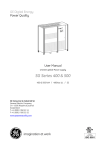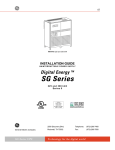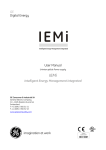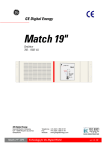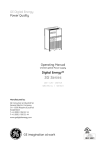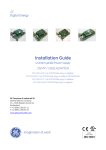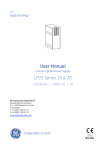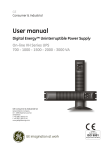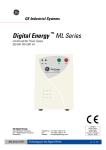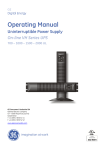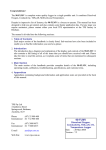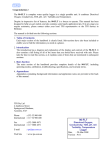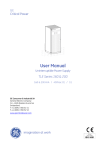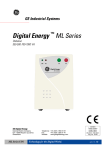Download SG Series 400 & 500
Transcript
GE Digital Energy Power Quality GE_01 0_S2_UPS_ SGS_400-50 Installation Guide Uninterruptible Power supply SG Series 400 & 500 400 & 500 kVA / 480Vac UL / S2 GE Consumer & Industrial SA General Electric Company CH – 6595 Riazzino (Locarno) Switzerland T +41 (0)91 / 850 51 51 F +41 (0)91 / 850 52 52 www.gepowerquality.com imagination at work Model: SG Series 400 & 500 UL S2 Issued by Product Document Department – Riazzino - CH Date of issue: 06/15/2010 File name: OPM_SGT_ISG_M40_M50_2US_V010 Revision: 1.0 Identification No.: Up-dating Revision Concerns Date COPYRIGHT © 2010 by GE Consumer & Industrial SA All rights reserved. The information contained in this publication is intended solely for the purposes indicated. The present publication and any other documentation supplied with the UPS system is not to be reproduced, either in part or in its entirety, without the prior written consent of GE. The illustrations and plans describing the equipment are intended as general reference only and are not necessarily complete in every detail. The content of this publication may be subject to modification without prior notice. Modifications reserved OPM_SGS_ISG_M40_M50_2US_V010.doc Page 2/41 User Manual SG Series 400 & 500 UL S2 Dear Customer, We thank you for selecting our products and are pleased to count you amongst our very valued customers at GE. We trust that the use of the SG Series 400 & 500 Uninterruptible Power Supply system, developed and produced to the highest standards of quality, will give you complete satisfaction. Please read carefully the Installation Guide, which contains all the necessary information and describes all you need to know about the installation of the UPS. Thank you for choosing GE ! START UP AND COMMISSIONING A GE GLOBAL SERVICES FIELD ENGINEER must perform start-up and commissioning of the UPS. Please Contact GE. GLOBAL SERVICES at least two weeks prior to schedule start-up and commissioning at 1-800-637-1738, or by E-mail at [email protected] . Distributed in the USA by: g GE Consumer & Industrial SA General Electric Company CH – 6595 Riazzino (Locarno) Switzerland www.gepowerquality.com Your service contact: g GE Digital Energy Power Quality 2501 Pecan Street Bonham, TX 75418 T: +1 800-637-1738 F: +1 903-640-0533 E: [email protected] http://www.gedigitalenergy.com/ups Modifications reserved OPM_SGS_ISG_M40_M50_2US_V010.doc Page 3/41 User Manual SG Series 400 & 500 UL S2 Preface Congratulations on your choice of a SG Series Uninterruptible Power Supply (UPS). It will help eliminate load disturbances due to unexpected power problem. This manual describes how to prepare the installation site, and it provides weight and dimensions and procedures for moving, installing and connecting the UPS. Please refer to the Operating Manual, which describes the function of the UPS module, the purpose and location of the switches, the meaning of the system events related to the front panel indication, and provides procedures for starting and stopping the equipment. While every care has been taken to ensure the completeness and accuracy of this manual, GE assumes no responsibility or liability for any losses or damages resulting from the use of the information contained in this document. WARNING! SG Series 400 & 500 is a product that needs to be installed by a licensed and knowledgeable contractor. We recommend that this manual be kept next to the UPS for future references. If any problems are encountered with the procedures contained in this manual, please contact your Service Center before you proceed. This document shall not be copied or reproduced without the permission of GE. Some of the information contained in this manual may be changed without notice to reflect technical improvements. Safety instructions Read the safety instructions contained on the following pages carefully before the installation of the UPS, options and battery system. Pay attention to the rectangular boxes included in the text: They contain important information and warning concerning electrical connections and personnel safety. Parallel version secured with RPA When included in the text, this symbol refers to operation needed only for parallel system. Modifications reserved OPM_SGS_ISG_M40_M50_2US_V010.doc Page 4/41 User Manual SG Series 400 & 500 UL S2 Table of contents Page 1 IMPORTANT SAFETY INSTRUCTIONS ........................................................................................................ 6 2 LAYOUT.......................................................................................................................................................... 9 2.1 3 LAYOUT SG Series 400 & 500 .......................................................................................................................................................9 INSTALLATION............................................................................................................................................ 10 3.1 TRANSPORT....................................................................................................................................................................................... 10 3.1.1 3.2 3.3 3.3.1 3.3.2 3.4 Power wiring of parallel units..................................................................................................................................................... 32 Parallel control bus connection................................................................................................................................................. 33 Control bus cable location ........................................................................................................................................................... 35 CUSTOMER INTERFACE ............................................................................................................................. 37 4.1 CUSTOMER INTERFACE ................................................................................................................................................................ 37 4.1.1 4.1.2 4.1.3 4.1.4 4.1.5 4.1.6 4.1.7 5 Power connections.......................................................................................................................................................................... 22 Power connection with common input utility..................................................................................................................... 24 Power connection dual input utility (option)........................................................................................................................ 26 Battery and External Battery Breaker connection ........................................................................................................... 29 Interface to External Bypass for single unit......................................................................................................................... 30 Connections to External Bypass switch in case of RPA Parallel System ................................................................ 30 Setup for SG Series 400 & 500 intended to be operated in eBoost™ Operation Mode.................................... 31 RPA PARALLEL SYSTEM CONNECTION .................................................................................................................................. 32 3.9.1 3.9.2 3.9.3 4 Utility input connection................................................................................................................................................................. 18 Input/output over current protection and wire sizing..................................................................................................... 19 Battery over current protection and wire sizing................................................................................................................ 20 WIRING CONNECTION.................................................................................................................................................................. 22 3.8.1 3.8.2 3.8.3 3.8.4 3.8.5 3.8.6 3.8.7 3.9 UPS location ....................................................................................................................................................................................... 12 Battery location ................................................................................................................................................................................ 14 VENTILATION AND COOLING..................................................................................................................................................... 15 UNPACKING ...................................................................................................................................................................................... 16 ELECTRICAL WIRING...................................................................................................................................................................... 18 3.7.1 3.7.2 3.7.3 3.8 Storage of the UPS .......................................................................................................................................................................... 11 Storage of battery ........................................................................................................................................................................... 11 PLACE OF INSTALLATION ............................................................................................................................................................ 12 3.4.1 3.4.2 3.5 3.6 3.7 Dimensions and weight................................................................................................................................................................. 10 DELIVERY ............................................................................................................................................................................................ 11 STORAGE ............................................................................................................................................................................................ 11 Serial Port J3 ...................................................................................................................................................................................... 38 Output free potential contacts .................................................................................................................................................. 38 Programmable input free contacts ......................................................................................................................................... 39 Gen Set Signaling (GEN ON)......................................................................................................................................................... 39 AUX external Maintenance Bypass ......................................................................................................................................... 39 Auxiliary Power Supply (APS) 24Vdc and Battery Breaker Release........................................................................... 39 EPO (Emergency Power Off) Input contact........................................................................................................................... 40 NOTES .......................................................................................................................................................... 41 5.1 NOTES FORM .................................................................................................................................................................................... 41 Modifications reserved OPM_SGS_ISG_M40_M50_2US_V010.doc Page 5/41 User Manual SG Series 400 & 500 UL S2 1 IMPORTANT SAFETY INSTRUCTIONS SAVE THESE INSTRUCTIONS This manual contains important instructions for models SG Series 400 & 500 that should be followed during installation and maintenance of the UPS and battery. GENERAL - Move the UPS in an upright position in its original package to the final destination room. To lift the cabinets, use a forklift or lifting belts with spreader bars. Check for sufficient floor and elevator loading capacity. Check the integrity of the UPS equipment carefully. If you notice visible damage, do not install or start the UPS. Contact the nearest Service Center immediately. WARNING! RISK OF ELECTRICAL SHOCK: Do not remove covers, there are no user serviceable parts inside. After switching off takes 5 minutes for the DC capacitors to discharge because a lethally high voltage remains at the terminals of the electrolytic capacitors. All maintenance and service work should be performed by qualified service personnel. The UPS contains its own energy source (battery). The field-wiring outlets may be electrically live, even when the UPS is disconnected from the utility. Dangerous voltages may be present during battery operation. The battery must be disconnected during maintenance or service work. This UPS contains potentially hazardous voltages. Be aware that the inverter can restart automatically after the utility voltage is restored. INSTALLATION - This UPS must be installed and connected only by trained personnel. Verify accurately during Commissioning and Maintenance of the UPS, for the following: Damaged components, squeezed wires and cables, or not correctly inserted plugs. After removing the sidewalls of the UPS, make sure that all earth connections when reassembling, are correctly reattached. This UPS is intended for use in a controlled indoor environment free of conductive contaminants and protected against animals intrusion. WARNING! HIGH EARTH LEAKAGE CURRENT: Earth connection is essential before connecting to AC input! Switching OFF the unit does not isolate the UPS from the utility. Do not install the UPS in an excessively humid environment or near water. Avoid spilling liquids on or dropping any foreign object into the UPS. The unit must be placed in a sufficiently ventilated area; the ambient temperature should not exceed 104°F (40°C). Optimal battery life is obtained if the ambient temperature does not exceed 77°F (25°C). It is important that air can move freely around and through the unit. Do not block the air vents. Avoid locations in direct sunlight or near heat sources. STORAGE - Store the UPS in a dry location; storage temperature must be within -13°F (-25°C) to 131°F (+55°C). The optimal temperature for Battery storage is 68°F (20°C) to 77°F (25°C) and shall never exceed the range 4°F (-20°C) to 104°F (40°C). If the unit is stored for a period exceeding 3 months, the battery must be recharged periodically (time depending on storage temperature). BATTERY - The battery-voltage is dangerous for person’s safety. When replacing the battery, use the same cells number, voltage (V), capacity (Ah). All the battery used, shall be of the same manufacturer and date of production. Proper disposal or recycling of the battery is required. Refer to your local codes for disposal requirements. Never dispose of battery in a fire: they may explode. Do not open or mutilate battery: their contents (electrolyte) may be extremely toxic. If exposed to electrolyte, wash immediately with plenty of water. Avoid charging in a sealed container. Never short-circuit the batteries. When working with batteries, remove watches, rings or other metal objects, and only use insulated tools. In case of air shipment, the cables +/- going to the battery fuses/terminals shall be disconnected and isolated. Modifications reserved OPM_SGS_ISG_M40_M50_2US_V010.doc Page 6/41 User Manual SG Series 400 & 500 UL S2 Safety instructions when working with battery EXTERNAL BATTERY MUST BE INSTALLED AND CONNECTED TO THE UPS BY QUALIFIED SERVICE PERSONNEL ONLY. INSTALLATION PERSONNEL MUST READ THIS ENTIRE SECTION BEFORE HANDLING THE UPS AND BATTERY. DANGER! Full voltage and current are always present at the battery terminals. The battery used in this system can provide dangerous voltages, extremely high currents and a risk of electric shock. If the terminals are shorted together or to ground they may cause severe injury. You must be extremely careful to avoid electric shock and burns caused by contacting battery terminals or shorting terminals during battery installation. Do not touch uninsulated battery terminals. A qualified service person, who is familiar with battery systems and required precautions, must install and service the battery. The installation must conform to national and local codes. Keep unauthorized personnel away from the battery. The qualified service person must take these precautions: 1 Wear protective clothing, such as rubber gloves and boots and protective eye wear Batteries contain caustic acids and toxic materials and can rupture or leak if mistreated. Remove rings and metal wristwatches or other metal objects and jewelry. Do not carry metal objects in your pockets where the objects can fall into the battery cabinet. 2 Tools must have insulated handles and must be insulated so that they will not short battery terminals. Do not allow a tool to short between individual or separate battery terminals or to the cabinet or rack. Do not lay tools or metal parts on top of the battery, and do not lay them where they could fall onto the battery or into the cabinet. 3 Install the battery as shown on the drawing provided with the battery. When connecting cables, never allow a cable to short across a battery’s terminals, the string of battery, or to the cabinet or rack. 4 Align the cables on the battery terminals so that the cable lug will not contact any part of the cabinet or rack, even if the battery is moved. Keep the cable away from any sharp metal edges. 5 Install the battery cables in such a way that the UPS or battery cabinet doors cannot pinch them. 6 Do not connect the battery terminal to Ground. If any battery terminal is inadvertently grounded, remove the source of the ground. Contacting any part of a grounded battery can cause a risk of electric shock. 7 To reduce the risk of fire or electric shock, install the battery in a temperature and humidity controlled indoor area, free of contaminants. 8 Battery system chassis ground (earth) must be connected to the UPS chassis ground (earth). If you use conduits, this ground conductor must be routed in the same conduit as the battery conductors. 9 Where conductors may be exposed to physical damage, protect the conductors in accordance with all applicable codes. 10 If you are replacing the battery or repairing battery connections, shut OFF the UPS and remove the battery fuses. Modifications reserved OPM_SGS_ISG_M40_M50_2US_V010.doc Page 7/41 User Manual SG Series 400 & 500 UL S2 Safety symbols and warnings Safety warnings The text of this manual contains some warnings to avoid risk to the persons and to avoid damages to the UPS system and the supplied critical loads. The non-observance of the warnings reminding hazardous situations could result in human injury and equipment damages. Please pay attention to the meaning of the following warnings and symbols. Throughout this manual the following symbols are defined: WARNING, if instruction is not followed injury or serious equipment damage may occur! CAUTION, internal parts have dangerous voltage present. Risk of electric shock! PE (Earth) – GND (Ground) PROTECTIVE GROUNDING TERMINAL: A terminal which must be connected to earth ground prior to making any other connection to the equipment. A terminal to which or from which an alternating (sine wave) current or voltage may be applied or supplied. A terminal to which or from which a direct current or voltage may be applied or supplied. This symbol indicated the word “phase”. This symbol indicates the principal on/off switch in the on position. This symbol indicates the principal on/off switch in the off position. Modifications reserved OPM_SGS_ISG_M40_M50_2US_V010.doc Page 8/41 User Manual SG Series 400 & 500 UL S2 2 LAYOUT 2.1 LAYOUT SG Series 400 & 500 SGS_400-5 00_S2_UP SGSU_400- S_GE_02 0 OFF 0 OFF I ON Q2 1 2 3 4 5 6 7 8 12 13 9 10 14 15 16 11 17 18 19 20 21 22 S_03 I ON Q1 500_S2_UP 12 1 2 3 4 5 6 7 12 13 14 8 9 15 16 10 11 17 18 19 20 21 22 Fig. 2.1-1 SG Series 400 & 500 general view Fig. 2.1-2 SG Series 400 & 500 general view with open doors SGSU_400 -500_S2_ UPS_04 1 4 1 Opening for top cable entry (*) 2 Opening entry(*) 3 Bus bars for Utility input and Load output 4 Bus bars for external Battery connection CR Connectivity Rack XA Terminals for 24Vdc Auxiliary Power Supply connection XB Terminals for EPO connection 3 0 OFF cable I ON Q2 0 OFF I ON Q1 for bottom 1 2 3 4 5 6 7 12 13 1 4 8 9 21 15 16 17 22 18 1 9 2 0 10 11 *) Remove this panel or provide XA/XB CR 2 means to capture metal filings from cutting conduit entry holes. Fig. 2.1-3 SG Series 400 & 500 general view with optional 5th harmonic filter and removed protection panels Modifications reserved OPM_SGS_ISG_M40_M50_2US_V010.doc Page 9/41 User Manual SG Series 400 & 500 UL S2 3 INSTALLATION 3.1 TRANSPORT Forklift Transport UPS only in upright position! The UPS is packaged on a pallet suitable for handling with a forklift. Pay attention to the center of gravity. The UPS must be moved in upright position. Do not tilt cabinets more than +/- 10° during handling. Move the UPS in it’s original package to the final destination site. Crane Do not stack other packages on top: This could damage the UPS. If the UPS must be lifted by crane, use suitable lifting straps and spreader bars. Note of the center of gravity marked on the package. Take all necessary precautions to avoid damage to the cabinet while hoisting the UPS. NOTE ! Check for sufficient floor and elevator loading capacity. Fig. 3.1-1 UPS cabinets moving 3.1.1 Dimensions and weight UPS -500_S2_ SGSU_400 US ns_GE_01 dimensio Dimensions SG Series 400 & 500 (W x D x H) H 80.71 x 33.47 x 76.78 inches 2,050 x 850 x 1,950 mm W D Fig. 3.1.1-1 UPS cabinet dimensions Weight SG Series 400 & 500 UPS rating Weight lbs / kg Floor loading lbs/sq.ft - kg/m2 SG Series 400 & 500 5,226 / 2,370 279 / 1,359 P.S.: Weights including the 5th harmonic filter. Modifications reserved OPM_SGS_ISG_M40_M50_2US_V010.doc Page 10/41 User Manual SG Series 400 & 500 UL S2 3.2 DELIVERY When delivered, inspect the package integrity and the physical conditions of the cabinets carefully. In case of any damage sustained during transport, immediately inform the carrier and contact your local Service Center. A detailed report of the damage is necessary for any insurance claim. NOTE ! A DAMAGED UPS MUST NEVER BE INSTALLED OR CONNECTED TO UTILITY OR BATTERY! 3.3 STORAGE 3.3.1 Storage of the UPS The UPS is carefully packed for transport and storage so that it is in perfect condition when installed. Never leave a UPS outside the building and don’t store other packages on the top of the UPS. It is advisable to store the UPS in its original package in a dry, dust-free room, away from chemical substances, and with a temperature range not exceeding -13°F (-25°C) to 131°F (55°C). In case the battery is included please refer to Section 3.3.2. Some important functions of the UPS, such as the customized functions, are defined by parameters stored in a RAM memory. A small backup battery located on the Control Unit board supplies the RAM. If the storage time of the UPS exceeds 1 year, these functions should be verified by an authorized Service Center before putting the UPS into operation. 3.3.2 Storage of battery When the delivery includes a maintenance free battery, keep in mind that they are subject to selfdischarge and therefore you must recharge the battery. The storage time without battery recharge depends on the temperature of the storage site. The optimal temperature for Battery storage is 68°F (20°C) to 77°F (25°C) and shall never exceed the range -4°F (-20°C) to 104°F (40°C). Recharge stored maintenance free battery every: 6 months when the storage temperature is 68°F (20°C) 3 months when the storage temperature is 86°F (30°C) 2 months when the storage temperature is 95°F (35°C) Modifications reserved OPM_SGS_ISG_M40_M50_2US_V010.doc Page 11/41 User Manual SG Series 400 & 500 UL S2 3.4 PLACE OF INSTALLATION 3.4.1 UPS location WARNING ! A QUALIFIED ELECTRICAL CONTRACTOR must carry out the installation and cabling of the UPS. If optional cabinets and accessories are included with the UPS, please refer to those accompanying manuals for installation and operating instructions. It is important to have a clean, dust-free environment provided with proper ventilation and airconditioning to keep the ambient temperature within the specified operating range. The recommended air inlet temperature is from 68°F (20°C) to 77°F (25°C) (max. 104°F / 40°C). Refer to Section 3.5. Check for sufficient floor load capacity before installing the UPS and the Battery. Refer to Section 3.1.1. For Battery installation follow the local codes and the recommendation of the battery supplier. NOTE ! Temperature is very important for valve-regulated batteries (maintenance free). Operation at temperatures higher than 77°F (25°C) will reduce battery life. The SG Series 400 & 500 UPS can radiate radio frequency energy. Although some RFI filtering is inherent to the UPS there is no guarantee that the UPS will not influence sensitive devices such as cameras and monitors that are positioned close by. If interference is expected, the UPS should be moved away from the sensitive equipment. A single-phase power outlet (120Vac) should be provided near the UPS for connection of power tools, test equipment or connectivity devices. This outlet must be grounded. Positioning of the UPS SG Series 400 & 500 Min. 20" / 500mm on_01 PS dispositi 00_S2_U SGSU_400-5 The rear panel of the UPS may be mounted flush to a wall or other structure. Clearance around the front of the unit should be sufficient to enable free passage of personnel with the doors fully open, and to allow sufficient airflow to the door vents. Check section 110-26(A) of the NEC code for specific requirements. Recommended minimum clearance between ceiling and top of the UPS should be 20” (500 mm) for proper cooling air exhaust. In case of additional cabinets (external Batteries or input, output transformers) these can be placed on either side of the cabinet. Fig. 3.4.1-1 SG Series 400 & 500 clearances Modifications reserved OPM_SGS_ISG_M40_M50_2US_V010.doc Page 12/41 User Manual SG Series 400 & 500 UL S2 Openings for input and output cable connections U_4 SGS 00-5 00_S PS 2_U Utility input Output Load Battery US _01 top view 80.71" 2,050mm 7.88" 200mm 1.58" 40mm 7" 1.9 mm 50 3" 29.5 mm .47" 33 mm 7 50 850 Fig. 3.4.1-2 Opening on top of the cabinet for input and output cables vie UPS S2 _ 00_ 00-5 U_4 SGS m otto wb Utility input Output Load Battery 80.71" 2,050mm US _01 7.88" 200mm 5" 3.1 m 80m 1.19" 30mm 6" 27.5 mm 7" 700 33.4mm 850 SG Series 400 & 500 openings are provided on the top and the bottom of the UPS for the connection of input and output cables. Pay attention to the position of these openings, when choosing the placement of the UPS. These openings are covered with a protective plate. Fig. 3.4.1-3 Opening on the bottom of the cabinet for input and output cables Fixing of the UPS cabinet on the floor The UPS cabinet is free standing and normally does not require to be bolted to the floor. The UPS cabinet can be fixed however to the floor by bolting it with the supporting blocks to the floor. See Fig. 3.4.1-4. 62.205" 1580mm 22.658" 575.5mm 22.028" 559.5mm 33.268" 845mm 28.740" 730mm = 30.040" 763mm = Ø 0.47305" Ø 12mm 1.378" 35mm 2.363" 60mm 1.378" 35mm 2.363" 60mm SGSU_400-500_S2_UPS view bottom_02US Front side Fig. 3.4.1-4 Fixing of the UPS cabinet on the floor Modifications reserved OPM_SGS_ISG_M40_M50_2US_V010.doc Page 13/41 User Manual SG Series 400 & 500 UL S2 A 500_S2_RP SGSU_400- disposition _GE_01US UPS 3-4-5-6 UPS 2 UPS 1 Fig. 3.4.1-5 RPA system disposition In case of parallel system, try to place the UPS modules in sequence of their numbers (marked on the packing). If the units are positioned “side by side”, the side panels must be mounted on all units. 3.4.2 Battery location Batteries require a well-ventilated room with controlled temperature to obtain reliable operation. The battery can be install immediately adjacent to the UPS (left or right side) or remotely from the UPS. If the battery is installed remotely from the UPS, a wall mounted DC disconnect device must be installed within line-of-site to both the UPS and the battery. The optimal room temperature for Battery storage is 68°F (20°C) to 77°F (25°C) and shall never exceed the range -4°F (-20°C) to 104°F (40°C). The life of valve-regulated batteries will be reduced by 50% for each additional 18°F (10°C) that the battery ambient temperature is above 77°F (25°C). The battery system associated with larger UPS is usually either rack mounted or installed in multiple battery cabinets. Installation and assembly must be made according to the local standards and battery system manufacturer‘s recommendations. The battery circuit breaker or battery fuse box must be mounted as near as possible to the battery. NOTE ! Battery installation and connection must be performed by QUALIFIED SERVICE PERSONNEL ONLY. Read all safety instructions before proceeding with the installation. Modifications reserved OPM_SGS_ISG_M40_M50_2US_V010.doc Page 14/41 User Manual SG Series 400 & 500 UL S2 3.5 VENTILATION AND COOLING Fig. 3.5-1 Installation on plain floor Fig. 3.5-2 Installation on raised floor The heat produced by the UPS is transferred to the environment by its ventilation. Air inlets for UPS ventilation are located on the front of the UPS, while air outlets are on top of the cabinet. A suitable ventilation or cooling system must be installed to extract the heat from the UPS room. NOTE ! Do not put anything on the top of the cabinet. Air filtration systems could be required when the UPS operates in a dirty environment. Contact your Dealer or the nearest Service Center for appropriate solutions. In order to prevent overheating of the UPS, the available air intake flow rate must exceed the total air exhaust flow rate requirement of the UPS system. The below table indicates the heat dissipation at full load at PF = 0.9 lag. and charged battery, up to 3,280 ft (1,000 m) altitude, for cooling air 77°F (25°C) to 86°F (30°C). Losses UPS rating with options Cooling air flow BTU / hr kW CFM m3 / h SG Series 400 with 5th filter 78,499 23.0 3,949 6,709 SG Series 400 with 5th & 11th filter 79,864 23.4 4,018 6,825 SG Series 400 in eBoost™ Operation Mode 13,652 4.0 687 1,167 SG Series 500 with 5th filter 99,659 29.2 5,013 8,517 SG Series 500 with 5th & 11th filter 101,366 29.7 5,099 8,663 SG Series 500 in eBoost™ Operation Mode 17,065 5.0 859 1,459 Modifications reserved OPM_SGS_ISG_M40_M50_2US_V010.doc Page 15/41 User Manual SG Series 400 & 500 UL S2 3.6 UNPACKING The UPS and Battery Cabinets may be shipped packaged in carton boxes or in wooden crates (if requested). Move the cabinets as close as possible to the final location before removing from the pallet. If delivered in a wooden crate, remove the cabinet from the pallet with care, because of the heavy weight of the equipment. White color Red color = = without any anomaly anomaly evidence The package of the SG Series 400 & 500 is equipped with ShockWatch (indicator for shock), and TiltWatch (indicator for overthrow) on the outside. Fig. 3.6-1 ShockWatch device These devices indicate an eventual shock or overthrow during transport. Whenever these devices show a possible anomaly, the UPS shall not be commissioned before consulting a “Service Center”. Fig. 3.6-2 TiltWatch device NOTE ! Take care not to damage the UPS when moving by forklift. A damaged UPS must never be installed or connected to Utility or Battery! In case of any damage sustained during the transport, immediately inform the shipping agent! A detailed report of the damage is necessary for any indemnity claim. Modifications reserved OPM_SGS_ISG_M40_M50_2US_V010.doc Page 16/41 User Manual SG Series 400 & 500 UL S2 Transport fastening to remove -500_S2_U SGSU_400 ing_01 ort fasten PS transp Rear side Fig. 3.6-3 Transport fastening to remove The chokes fitted in the UPS cabinet are supported both at the chassis. These supports must be removed before placing the cabinet in the final location. These supports are yellow and are indicated with an appropriate symbol on the assembly layout drawing (see Fig. 3.6-1). For parallel systems, the delivery also includes the bus control cables for interconnecting the UPS modules. Packing material recycling GE, in compliance with environment protection, use only environmentally friendly material. UPS packing materials must be recycled in compliance with all applicable regulations. Modifications reserved OPM_SGS_ISG_M40_M50_2US_V010.doc Page 17/41 User Manual SG Series 400 & 500 UL S2 3.7 ELECTRICAL WIRING WARNING ! UPS installation and connection must be performed by QUALIFIED SERVICE PERSONNEL ONLY. It is the responsibility of the installation technician to ensure that all local and national electric codes are adhered to. 3.7.1 Utility input connection NOTE ! Ensure that the AC and DC external isolators are OFF and locked out to prevent their inadvertent operation. Do not apply power to the equipment prior to the commissioning by a QUALIFIED SERVICE ENGINEER. Before any other input connection, connect and check the grounding wire. The UPS has available input terminations for the Rectifier and Bypass. The unit may be powered from a common input source or dual input (option) sources if desired. Common Input Rectifier & Bypass The same power source is to be used for both Bypass Supply and Rectifier Input (input F3). Bear in mind that when the Utility Fuses are opened there is a supply failure to the Rectifier as well as to the Bypass and Manual Bypass. In this case, the interconnection links BR1, BR2 and BR3 on the input terminals or bus bars MUST REMAIN CONNECTED. See Fig. 3.8.3-3. Dual Input Configuration Rectifier & Bypass (option) The Bypass and Rectifier inputs are to be powered from different Utility supplies (F1 and F2 inputs). In this case, when the Rectifier Input Fuses are opened, the Bypass and the Manual Bypass are supplied by the other source. In this case, REMOVE the interconnection links BR1, BR2 and BR3 on the input terminals or bus bars. See Fig. 3.8.3-3. Dual Input Configuration Rectifier & Bypass (option) Common Input Rectifier & Bypass Fig. 3.7.1-1 Dual Input Configuration Rectifier & Bypass (option) Fig. 3.7.1-2 Common Input Rectifier & Bypass 1 = Rectifier 2 = Inverter Modifications reserved OPM_SGS_ISG_M40_M50_2US_V010.doc 3 = Automatic Bypass 4 = Manual Bypass Q2 (option) 6 = Load 5 = Utility input 7 = Battery Page 18/41 User Manual SG Series 400 & 500 UL S2 3.7.2 Input/output over current protection and wire sizing The cabling of the UPS system has to be sized according to the UPS power rating. Sizing of circuit breakers, fuses and cables for Input Utility, Output Load and Battery must meet the requirements of local and national electrical codes. Before connecting the UPS, verify that the Utility Voltage and Frequency, the Output Load Voltage and Frequency and Battery Data (cells number, floating voltage, autonomy) are according to the required specifications. Output load configuration may be such that one phase may carry a load current at 100% of that phases maximum current rating while the other two phases run at 0% or any combination in between. Ensure that the load does not consist of any equipment that may require high starting currents such as electric motors, laser printers, etc. This may cause the UPS to occasionally go into Bypass due to overload conditions To choose the correct input fuses or circuit breaker, consider the available short-circuit current of the system up-stream. Choose the correct fuse or breaker using current data shown in the chart and the appropriate NEC code. The ratings indicated in the following chart do not consider any line voltage drop. In case of optional input transformer the input protective devices should be sized to allow the transformer magnetization inrush current. Caution when using four-pole circuit breakers as protection. A potential problem exists for situations with non-linear loads: The neutral current could be greater than the phase currents. The three-phase Utility power supply must be symmetrical with respect to ground, due to the existence of voltage surge protection devices inside the UPS. NOTE ! If you use ELCB breaker (Earth Limiting Circuit Breaker) to protect the input connections, consider the high leakage current generated by the noise suppression capacitors. If these ELCB breakers are strictly necessary, we suggest using the largest type suitable for non-linear current and for delayed operations. To ensure coordination when the UPS is configured for Separate Bypass and Rectifier Inputs, special care must be taken in choosing the fuse or circuit breaker ratings installed in the output distribution circuits. Protective devices on the output of the UPS should be coordinated with the Bypass Input circuit protection. Due to the relatively low short circuit capability of the UPS inverter, a short circuit in the load will cause an immediate transfer to Bypass. The largest fuse or circuit breaker in the output distribution should be rated at no more than 60% of the rating of the protective device supplying the Bypass line. If circuit selectivity is required while the load is fed from the inverter (Bypass Utility not available), the largest fuse or circuit breaker should be rated at no more than 20% of the UPS output current rating. Modifications reserved OPM_SGS_ISG_M40_M50_2US_V010.doc Page 19/41 User Manual SG Series 400 & 500 UL S2 3.7.3 Battery over current protection and wire sizing NOTE ! • • • • • • Please read the safety precautions at the front of this guide carefully, and thoroughly review the battery manufacturers installation and maintenance manual before connecting the batteries to the UPS. The remote rack mounted batteries are to be used then DC over current protection must be provided by others. Choose an appropriate DC fuse or circuit breaker using the current data in the chart below. Minimum battery cable requirement is based on the current data below. The maximum available fault current from the battery supply is: 20kA. The minimum breaker voltage rating is 540V The AC values below are current ratings per phase. These maximum and nominal ratings should be considered when choosing the appropriate AC over current protection device. NEC (National Electric Code) Section 210-20 a rules must be applied. DC current rating is the nominal battery discharge current which the UPS allows. (See Fig. 3.7.1-1 and 3.7.1.2) UPS rating AC Input Rectifier F1 Nom. Max. AC Input Bypass F2 AC Input F3 Nom. Max. DC Input F4 SG Series 400 512 A 615 A 481 A 512 A 615 A 702 A SG Series 500 617 A 708 A 600 A 617 A 708 A 960 A Size of Branch Circuit Over Current Protection - All Models: - "CAUTION - To reduce the risk of fire, only connect UPS to a circuit provided with (See below) maximum amperes branch circuit over current protection in accordance with the NEC (National Electric Code), NSI / NFPA 70 UPS rating AC Input Rectifier F1 AC Input Bypass F2 AC Input F3 DC Input F4 SG Series 400 800 A 700 A 800 A 1,000 A SG Series 500 1,000 A 800 A 1,000 A 1,200 A WIRING Wire sizing according to NEC Section 210-20 (a) Table 310-16 Use 75°C (167°F) copper wire Wiring requirements: AC INPUT RECTIFIER: 3-Phase, 3 wire plus Ground AC INPUT BYPASS: 3-Phase, 4 wire plus Ground AC OUTPUT: 3-Phase, 4 wire plus Ground DC INPUT: 2 wire (positive and negative) plus Ground Maximum recommended cable size UPS rating Rectifier Input Bypass Input DC Input AC Output GND SG Series 400 SG Series 500 4x500 kcmil 4x500 kcmil 4x600 kcmil 4x500 kcmil 3x500 kcmil Modifications reserved OPM_SGS_ISG_M40_M50_2US_V010.doc Page 20/41 User Manual SG Series 400 & 500 UL S2 NEC SECTION 210-20 (a) Table 310-16. Allowable Ampacities of Insulated Conductors Rated O Through 2000 Volts, 60°C Trough 90°C (140°F Trough 194°F) Not More than Three Current-Carrying Conductors in Raceway, Cable, or Earth (Directly Buried), Based on Ambient Temperature of 30°C (86°F). Temperature Rating of Conductor (See table 310-13) Size 60°C (140°F) 75°C (167°F) 90°C (194°F) 60°C (140°F) 75°C (167°F) 90°C (194°F) Types TW, UF Types FEPW, RH, RHW, THHW, THW, THWN, XHHW, USE, ZW Types TBS, SA, SIS, FEP, FEPB, MI, RHH, RHW-2, THHN, THHW, THW-2, THWN-2, USE-2, XHH, XHHW, XHHW-2,ZW-2 Types TW, UF Types RH, RHW, THHW, THW, THWN, XHHW, USE Types TBS, SA, SIS, THHN, THHW, THW-2, THWN-2, RHH, RHW-2, USE-2, XHH, XHHW, XHHW-2, ZW-2 AWG or kcmil COPPER ----20 25 30 40 55 70 85 95 110 125 145 165 195 215 240 260 280 320 355 385 400 410 435 455 495 520 545 560 18 16 14 12 10 8 6 4 3 2 1 1/0 2/0 3/0 4/0 250 300 350 400 500 600 700 750 800 900 1000 1250 1500 1750 2000 ----20 25 35 50 65 85 100 115 130 150 175 200 230 255 285 310 335 380 420 460 475 490 520 545 590 625 650 665 ALUMINIUM or COPPER-CLAD ALUMINIUM 14 18 25 30 40 55 75 95 110 130 150 170 195 225 260 290 320 350 380 430 475 520 535 555 585 615 665 705 735 750 ------20 25 30 40 55 65 75 85 100 115 130 150 170 190 210 225 260 285 310 320 330 355 375 405 435 455 470 ------20 30 40 50 65 75 90 100 120 135 155 180 205 230 250 270 310 340 375 385 395 425 445 485 520 545 560 ------25 35 45 60 75 85 100 115 135 150 175 205 230 255 280 305 350 385 420 435 450 480 500 545 585 615 630 CORRECTION FACTORS Ambient Temp. (°C) For ambient temperatures other than 30°C (86°F), multiply the allowable ampacities shown above by the appropriate factor below 21 - 25 26 - 30 31 - 35 36 - 40 41 - 45 46 - 50 51 - 55 1.08 1.00 0.91 0.82 0.71 0.58 0.41 Modifications reserved OPM_SGS_ISG_M40_M50_2US_V010.doc 1.05 1.00 0.94 0.88 0.82 0.75 0.67 1.04 1.00 0.96 0.91 0.87 0.82 0.76 1.08 1.00 0.91 0.82 0.71 0.58 0.41 1.05 1.00 0.94 0.88 0.82 0.75 0.67 1.04 1.00 0.96 0.91 0.87 0.82 0.76 Page 21/41 User Manual SG Series 400 & 500 UL S2 3.8 WIRING CONNECTION WARNING! UPS installation and connection must be performed by QUALIFIED SERVICE PERSONNEL ONLY. 3.8.1 Power connections Input/output and DC connections are provided with terminal blocks. Please refer to chart for torque specifications. Carefully read the following recommendations before proceeding: • Ensure that the AC and DC external isolators are OFF and locked to prevent their inadvertent operation. • Do not close any external isolators prior the commissioning of the equipment. • The preferred power cable entry location for installation purposes is from the right side of the UPS, either top or bottom. In case of cable entry from the top of the cabinet, remove the cover plate fitted on the roof and provide for a suitable isolated protection cover. In case of cable entry from the bottom remove cover plate and perform the same procedure. • If the UPS is installed in such a way that the accessibility to the right side panel is reduced, field wiring connections can be made from the front side by removing the front right side panel protection cover/panel ( E ) as indicated in Fig. 3.8.1-1 be advised that installation performed from the front position will give the installer reduced visibility to the terminal lugs. • The input/output cables must be connected in clockwise phase rotation for both Bypass and Rectifier Input Terminals if separate, taking care to avoid risk of short circuit between different poles. • The grounding and neutral connection of the electrical system must be in accordance with local regulations. • In case of additional cabinets containing batteries, input/ output transformers, etc, their ground terminals must be connected to the UPS main ground terminal. • Once the power cables have been connected, re-install the internal safety shields and close the cabinets by re-installing all external panels. Torque Specifications Lugs bolted to Buss Blades Input / Output / Neutral / Battery and GND UPS rating BOLT Size (inches) BOLT Torque (Lb-in) BOLT Torque (N-m) SG Series 400 & 500 1/2 428 48 Modifications reserved OPM_SGS_ISG_M40_M50_2US_V010.doc Page 22/41 User Manual SG Series 400 & 500 UL S2 CAUTION ! Panel “A, B, C and D” should never be removed or replaced with power applied to the UPS. This panel is in close proximity to 480V live buss bars. Always disconnect the rectifier, bypass, load and battery sources from the UPS before removing or replacing this panel. If not serious injury or death could occur! Access to power wiring terminals for the cable connections. Top entry cables SGSU_400 -500_S2_ UPS conn ection_01 US ! Please remove the plate before drilling any holes B C D Q1 0 OFF I ON Q2 0 OFF I ON A Bottom entry cables ! Please remove the plate before drilling any holes Detail of the power wiring terminal for external battery connection Detail of the power wiring terminal for the AC input/output 1.75" 44.5mm 2" 51mm 2" 51mm 2" 51mm 1.02" 26mm 7" 0.5 mm 14.5 0.98" 1.97" 0.98" 25mm 50mm 25mm Ø 0.55" / 14mm 7" 0.5 mm 14.5 " 31.5 m 80m Ø 0.55" / 14mm 1.75" 44.5mm 0.79" 20mm Fig. 3.8.1-1 Access to the input / output connections To access input, output and Battery Connections proceed as follows: • Remove the protection panel “A, B and C”. • Remove the UPS side panel “D”. Modifications reserved OPM_SGS_ISG_M40_M50_2US_V010.doc Page 23/41 User Manual SG Series 400 & 500 UL S2 3.8.2 Power connection with common input utility SGS _4 0 0-5 00_ S2_ UP S con nec tion c om mo n _G E_0 PE PE Input Utility PE Load 1US + - PE Typical installation using common NEMA two hole lugs Load Neutral Utility Neutral L3-1 L2-1 L1-1 1 - INPUT UTILITY RECTIFIER & BYPASS PE L3 L2 Position of the PE bolt in case the cable input is from the bottom of the UPS Load Typical installation using common NEMA two hole lugs L1 Fig. 3.8.2-1 Power connections Common Input Utility Use 1/2” bolts for the cable connections on INPUT / OUTPUT power wiring Bus Bars. Cable terminations are to the Rectifier Input / Output Bus Bars as shown above. Connect wire to the Bus Bars using appropriate tools and appropriate torque. Torque specification for two hole lugs on Bus Bars: see Section 3.8.1. Common Input Rectifier / Bypass L1-1 Rectifier + Bypass Phase A L2-1 Rectifier + Bypass Phase B L3-1 Rectifier + Bypass Phase C N Utility Neutral PE Input Utility Ground The interconnection bus bars BR1, BR2 and BR3 MUST REMAIN CONNECTED (see Fig. 3.8.3-3). Output Load L1 Load Phase A L2 Load Phase B N Load Neutral PE Load Load Ground Modifications reserved OPM_SGS_ISG_M40_M50_2US_V010.doc L3 Load Phase C Page 24/41 User Manual SG Series 400 & 500 UL S2 NOTE ! This UPS is only designed to operate in a wye-configured electrical system with a solidly grounded neutral. The UPS cannot be operated from a mid-point or end-point grounded delta supply source. If the Load requires a Neutral, a Bypass Source Neutral MUST BE PROVIDED. If no Neutral Connection is available with the Bypass Input (3-wire input + ground) and the Load does not require a Neutral, solidly connect the Output Neutral of the UPS to ground with a ground bonding jumper. For single module applications install the ground bonding jumper directly at the UPS output. Cable size for this connection shall be per National Electric Code and applicable local regulations, but not less then AWG 3/0. Attention: With this configuration, Load can only be connected phase-phase. Absolutely no Load Connection permitted to the Neutral of the output transformer. DO NOT install both a source Neutral and a bonding jumper! In a RPA Parallel System configuration it is most important to connect the Neutrals of the UPS outputs together. The output distribution cabinet must contain a Neutral Bus (see Fig .3.8.2-2). If no Neutral Connection is available with the Bypass Input (3-wire input + ground) and the Load does not require a Neutral, solidly connect the Output Neutral of the UPS to ground in the Output Distribution Cabinet. Wire Neutral Conductors from the UPS to the output distribution cabinet (common point of connection) and solidly connect to ground with a Fig. 3.8.2-2 RPA Parallel System ground bonding jumper. Cable size for the ground bonding jumper shall be per National Electric Code and applicable local regulations, but not less then AWG 3/0. Attention: DO NOT INSTALL both a source Neutral and a bonding jumper. If the UPS is equipped with an Input Bypass Transformer, the Secondary of the transformer must be wye-configured with Neutral Solidly Grounded. The Neutral of the Output Transformer must be connected to the wye secondary winding of the Bypass Transformer. eBoost™ Operation Mode For installations intended to be operated in eBoost™ Operation Mode, the Input Neutral Conductor must be connected from the source of supply. An Input Neutral Conductor MUST be pulled into the UPS. Neutral to ground bonding jumper shall NOT be installed in UPS installations intended to be operated in eBoost™ Operation Mode. Contact your Service Center, which will help you to find valuable solutions. Modifications reserved OPM_SGS_ISG_M40_M50_2US_V010.doc Page 25/41 User Manual SG Series 400 & 500 UL S2 3.8.3 Power connection dual input utility (option) SGS _4 0 0-5 00_ S2_ UP S co nne c tion sep ara te_ GE PE PE Input Utility PE Load _01 US PE + - Typical installation using common NEMA two hole lugs Load Neutral Utility Neutral L3-1 L2-1 1 - INPUT UTILITY RECTIFIER L1-1 IN B Y PUT PA UT SS ILI (op TY tio n) L3-2 L2-2 L1-2 2- PE L3 L2 Position of the PE bolt in case the cable input is from the bottom of the UPS Load Typical installation using common NEMA two hole lugs L1 Fig. 3.8.3-1 Power connections Dual Input Utility (option) Use 1/2” bolts for the cable connections on INPUT / OUTPUT power wiring Bus Bars. Cable terminations are to the Rectifier Input / Output Bus Bars as shown above. Connect wire to the Bus Bars using appropriate tools and appropriate torque. Torque specification for two hole lugs on Bus Bars: see Section 3.8.1. Dual Input Configuration Rectifier / Bypass (option) L1-1 Rectifier Phase A L1-2 Bypass Phase A L2-1 Rectifier Phase B L2-2 Bypass Phase B L3-1 Rectifier Phase C L3-2 Bypass Phase C N - Bypass Bypass Neutral PE Input Utility Ground For dual input configurations, a neutral conductor is required from the bypass source only. The interconnection links BR1, BR2 and BR3 MUST BE REMOVED (see Fig. 3.8.3-3). Output Load L1 Load Phase A L2 Load Phase B N Load Neutral PE Load Load Ground Modifications reserved OPM_SGS_ISG_M40_M50_2US_V010.doc L3 Load Phase C Page 26/41 User Manual SG Series 400 & 500 UL S2 NOTE ! This UPS is only designed to operate in a wye-configured electrical system with a solidly grounded neutral. The UPS cannot be operated from a mid-point or end-point grounded delta supply source. If the Load requires a Neutral, a Bypass Source Neutral MUST BE PROVIDED. If no Neutral Connection is available with the Bypass Input (3-wire input + ground) and the Load does not require a Neutral, solidly connect the Output Neutral of the UPS to ground with a ground bonding jumper. For single module applications install the ground bonding jumper directly at the UPS output. Cable size for this connection shall be per National Electric Code and applicable local regulations, but not less then AWG 3/0. Attention: With this configuration, Load can only be connected phase-phase. Absolutely no Load Connection permitted to the Neutral of the output transformer. DO NOT install both a source Neutral and a bonding jumper! In a RPA Parallel System configuration it is most important to connect the Neutrals of the UPS outputs together. The output distribution cabinet must contain a Neutral Bus (see Fig .3.8.3-2). If no Neutral Connection is available with the Bypass Input (3-wire input + ground) and the Load does not require a Neutral, solidly connect the Output Neutral of the UPS to ground in the Output Distribution Cabinet. Wire Neutral Conductors from the UPS to the output distribution cabinet (common point of connection) and solidly connect to ground with a Fig. 3.8.3-2 RPA Parallel System ground bonding jumper. Cable size for the ground bonding jumper shall be per National Electric Code and applicable local regulations, but not less then AWG 3/0. Attention: DO NOT INSTALL both a source Neutral and a bonding jumper. If the UPS is equipped with an Input Bypass Transformer, the Secondary of the transformer must be wye-configured with Neutral Solidly Grounded. The Neutral of the Output Transformer must be connected to the wye secondary winding of the Bypass Transformer. eBoost™ Operation Mode For installations intended to be operated in eBoost™ Operation Mode, the Input Neutral Conductor must be connected from the source of supply. An Input Neutral Conductor MUST be pulled into the UPS. Neutral to ground bonding jumper shall NOT be installed in UPS installations intended to be operated in eBoost™ Operation Mode. Contact your Service Center, which will help you to find valuable solutions. Modifications reserved OPM_SGS_ISG_M40_M50_2US_V010.doc Page 27/41 User Manual SG Series 400 & 500 UL S2 Notices for installation SGSU_400 -500_S2_U PS BR1-2-3_ GE_01 L3-1 L2-1 L1-1 L3-2 BR3 BR2 L2-2 L1-2 BR1 Fig. 3.8.3-3 AC bus bars BR1, BR2 and BR3 For separate Bypass and Rectifier input configuration (option), the AC Bus Bars BR1, BR2 and BR3 MUST BE REMOVED. Modifications reserved OPM_SGS_ISG_M40_M50_2US_V010.doc Page 28/41 User Manual SG Series 400 & 500 UL S2 3.8.4 Battery and External Battery Breaker connection S GS U_4 00-5 00_ S2_ UPS con nec tion batt ery _GE _01 US PE Typical installation using common NEMA two hole lugs + - PE Fig. 3.8.4-1 Power connections Battery Use 1/2” bolts for the cable connections on BATTERY power wiring Bus Bars. Battery Cable Terminations are to the Positive and Negative Terminals as shown above. Connect wire to the Bus Bars using appropriate tools and appropriate torque. Torque specification for two hole lugs on Bus Bars: see Section 3.8.1. Battery connection + Positive pole of the battery - Negative pole of the battery PE Battery ground Do not insert the Battery Fuses before the commissioning! NOTE ! To meet standards concerning electromagnetic compliance, the connection between the UPS and external Battery must be done by using a shielded cable or suitable shielded (steel) conduit! External Battery Breaker Release For connection or disconnection of the Battery an external breaker CB with UVR is required. The UVR of the external breaker must be connected to terminal XA (see Fig. 4.1.6-1). Fig. 3.8.4-2 External battery breaker connection The release signal will allow, after the Rectifier soft-start, the manual closure of the breaker. In either case, fuses or breaker, an auxiliary contact must signalize the closure of breaker or fuse holder to Input channel 1 of the P4 - Customer Interface (see Section 4.1). Contact must be open with Battery disconnected (Normally Open). Modifications reserved OPM_SGS_ISG_M40_M50_2US_V010.doc Page 29/41 User Manual SG Series 400 & 500 UL S2 3.8.5 Interface to External Bypass for single unit If the UPS system is equipped with an External Maintenance Bypass Switch, connect the NO (normally open) voltage free auxiliary contact from the External Bypass Switch to X4 - 1, 2 of P27 – IM0108 Interface for External Bypass inserted in the Connectivity Rack. When this NO (Normally Open) contact closes, the Inverter Output Contactor K7 opens and the Load transfer to Inverter will be inhibited. SG Series 400 & 500 has to be interfaced to the External Bypass Auxiliary Contacts (NO) for safety reasons. This will prevent contactor K7 from closing when the external bypass breaker is on. The connections shown in the diagram are mandatory. Fig. 3.8.5-1 Interface to External Bypass for single unit 3.8.6 Connections to External Bypass switch in case of RPA Parallel System In a parallel system, this connection must be made between each UPS to a separate AUX contact of the External Maintenance Bypass Switch. Fig. 3.8.6-1 Connections to External Bypass switch in case of RPA Parallel System Modifications reserved OPM_SGS_ISG_M40_M50_2US_V010.doc Page 30/41 User Manual SG Series 400 & 500 UL S2 3.8.7 Setup for SG Series 400 & 500 intended to be operated in eBoost™ Operation Mode NOTE ! For systems intended to be operated in eBoost™ Operation Mode, the installation shall be protected with suitable surge protection devices (SPDs) on the AC bus feeding the UPSs. Please contact your Service Center for more information. When using the “eBoost/IEMi control” function on the programmable user relays of the customer interface X1/J2 terminals in a Parallel System, a separate NO (Normally Open) contact must be connected to each individual unit. Modifications reserved OPM_SGS_ISG_M40_M50_2US_V010.doc Page 31/41 User Manual SG Series 400 & 500 UL S2 3.9 RPA PARALLEL SYSTEM CONNECTION WARNING ! This operation must be performed by QUALIFIED SERVICE PERSONNEL ONLY before the initial start-up. ENSURE THAT THE UPS INSTALLATION IS COMPLETELY POWERED DOWN. 3.9.1 Power wiring of parallel units To guarantee good Load sharing between the units of a Parallel System, we recommend that the cable length from the input distribution board (5) to the output distribution board (9) is equal for each unit (a+b = c+d = e+f = g+h = i+l = m+n). Tolerance: +/- 10%. The RPA Cable Saver option introduces a bypass inductor in every UPS module, minimizing the influence of external conductor length on bypass current sharing. The RPA Cable Saver option extends the cable length tolerance to +/-50% for runs not exceeding 160 feet (49m). The AC input power of the Bypass must be the same for all units of the parallel system - no phase shift allowed between units. NOTE ! It is strongly recommended that no transformers, automatic circuit breakers or fuses be inserted between the unit’s output and the Load common bus bars. However, it is recommended that a disconnection or isolation switch be installed in order to totally isolate a unit if needed. Verify that power wiring and control wiring are run in separate conduits or cable trays. UPS input cables must be run in separate conduits from the output cables. Fig. 3.9.1-1 Power wiring of RPA Parallel System Modifications reserved OPM_SGS_ISG_M40_M50_2US_V010.doc 1 2 3 4 5 6 7 8 = = = = = = = = 9 = c 2 3 4 5 6 = = = = = = Rectifier Inverter Automatic Bypass Manual Bypass (option) Input Utility Distribution Unit Output Load External Battery fuse or MCB External Battery Common bus bar and Output Load Distribution UPS Number 1 UPS Number 2 UPS Number 3 UPS Number 4 UPS Number 5 UPS Number 6 Page 32/41 User Manual SG Series 400 & 500 UL S2 3.9.2 Parallel control bus connection In cases of parallel operation, the communication between the units takes place through the control bus cables. Each parallel unit is equipped with an additional board “P13 – RPA Board“ where the connectors J52 (A) and J62 (B) are located. A short control cable provided with a ferrite ring core links the parallel board “P13 – RPA Board” with the parallel bus socket on which must be connected the control bus cables JA and JB on PCB “P34 – Bus Interface”. All the parallel units are connected to the same control bus. This connection allows: • The microprocessors of each unit to communicate with each other. • The oscillators of each unit to be locked together. • The regulation loops to compare the output current of each unit in order to equally share the load current. For increased reliability, this connection is made with redundant cables. In this way, communication is maintained between units in case one of the control cables should fail or be accidentally damaged or disconnected. The standard length of the control bus cable between two parallel unit is 40 ft / 12 m. Maximal overall length of bus connection, between the first and the last unit, should not be longer than 276 ft / 84 m. Verify that control wiring is run in individual separate steel conduit. NOTE ! Under no circumstance should the control bus cable connecting JA (1/2/3/4/5) and JB (1/2/3/4/5) be connected or disconnected after the system has been powered On. JP2 IM 0048 JP1 JB2 JB1 JB JP2 JA2 JA3 JP2 JP3 JP4 JP1 JP2 JB1 JP4 IM 0048 JP1 JA JP1 JA JB JP2 JB3 JB2 IM 0048 JP3 JA JB JP2 JP3 JP4 JA1 JA2 JP1 JP3 JP4 JA1 JP4 JP3 JP4 UPS 3 UPS 2 JP3 UPS 1 JP1 SGSU_400-500_S2_RPA-IM0048_01US JA1 + JB1 JA2 + JB2 Next parallel unit 4, 5, 6 JA3 + JB3 Fig. 3.9.2-1 RPA System - Control bus connection The shield of the control bus cable, connected on JA and JB must be connected to ground with the appropriate cable clamps fitted on parallel bus socket. It is important to place the units in sequence of their assigned number. A unit number from 1 to 6, is defined by the setting of parameters and displayed on the panel. This number is also marked inside and outside the packaging. Modifications reserved OPM_SGS_ISG_M40_M50_2US_V010.doc Page 33/41 User Manual SG Series 400 & 500 UL S2 JP3 JP4 JA1 JP3 JP1 JP2 IM 0048 JB JP2 JP4 JA JP1 JB1 SGSU_400-500_S2_RPA-IM0048_02 Fig. 3.9.2-2 Bus connection on terminal units Terminal units On the parallel bus PCB “P34 – Bus Interface”, of the first and last units (terminal) of the parallel system the Jumpers JP1, JP2, JP3 and JP4 MUST BE INSERTED. JP3 JP4 JP3 JP1 JP2 IM 0048 JB JP2 JP4 JA JA1 JA2 JP1 JB2 JB1 SGSU_400-500_S2_RPA-IM0048_03 Fig. 3.9.2-3 Bus connection on intermediate units Intermediate units On the parallel bus PCB “P34 – Bus Interface” of the intermediate units of the parallel system the Jumpers JP1, JP2, JP3 and JP4 MUST BE REMOVED. NOTE ! In a parallel system composed of 2 or more units, only the first and last units (having 1 input JA and JB free) have the Jumper JP1, JP2, JP3 and JP4 inserted on parallel bus PCB “P34 – Bus Interface” (see Fig. 3.9.2-2). Modifications reserved OPM_SGS_ISG_M40_M50_2US_V010.doc Page 34/41 User Manual SG Series 400 & 500 UL S2 3.9.3 Control bus cable location WARNING ! This operation must be performed by QUALIFIED SERVICE PERSONNEL ONLY before the initial start-up. ENSURE THAT THE UPS INSTALLATION IS COMPLETELY POWERED DOWN. SGS_400-5 00_S2_RPA control bus cable_ 01US Access to connection. 0 OFF 0 OFF I ON Q2 control bus The control bus connection between parallel units must be made on the electronic module (P34 – Bus Interface) situated at the inside of the UPS door. I ON Q1 the 1 2 3 4 5 6 7 8 12 13 14 9 21 1 5 16 22 17 18 19 20 10 11 Next Para llel Unit Fig. 3.9.3-1 View electronic module on intermediate unit Control bus cables connection. JA -50 SGSU_400 A 0_S2_RPA s control bu S cable_02U B Plug the cables JA (1/2/3/4/5) and JB (1/2/3/4/5) onto the RJ connectors JA and JB located on parallel bus PCB “P34 – Bus Interface” (going to “P13 – RPA Board” J52(A) and J62(B). • Fix both cables JA (1/2/3/4/5) and JB (1/2/3/4/5) to parallel bus socket connecting the cable shield to ground by means the cable clamps “A“. JA1 JA2 JA1 JB • JA2 Next parallel unit Fig. 3.9.3-2 Front view electronic module on intermediate unit Modifications reserved OPM_SGS_ISG_M40_M50_2US_V010.doc Page 35/41 User Manual SG Series 400 & 500 UL S2 SGSU_400 -500_S2_R PA control bus cable _03US JA JA1 JB1 Q1 0 OFF I ON JB JA 0 OFF JA1 JA2 JB1 JB2 Q1 0 OFF I ON JB I ON Q2 1 2 3 4 5 6 7 8 12 13 14 9 21 15 16 22 17 18 19 2 0 10 11 UPS 1 JA1 0 OFF I ON Q2 JB1 1 2 3 4 5 6 7 8 9 12 13 14 21 22 15 1 6 17 18 19 20 10 11 UPS 2 JB2 JA2 Next Para llel Unit 3, 4, 5, 6 Fig. 3.9.3-3 Control bus cable routing and connection Control bus cables routing Place and fix the cables JA-1/2/3/4/5 and JB-1/2/3/4/5 inside the UPS cabinets in the position illustrated in the drawing. NOTE ! Pay attention when cabling and routing the bus cables JA and JB inside the UPS cabinet. In case one unit should be removed from the parallel system, the bus cables JA and JB must be removed from the cabinet without disconnecting them from the metal plate where the sockets JA and JB are located. For reliability reasons the cables JA-1/2/3/4/5 and JB-1/2/3/4/5 connecting the units should be run in separated protected conduits (as indicated in Fig. 3.9.3-3) separated from the power cables. It is important that the cable JA must be the same length as cable JB. WARNING ! Connection and commissioning of an additional UPS to an existing parallel system, must be performed by a GE SERVICE ENGINEER from of your Service Center. Modifications reserved OPM_SGS_ISG_M40_M50_2US_V010.doc Page 36/41 User Manual SG Series 400 & 500 UL S2 4 CUSTOMER INTERFACE 4.1 CUSTOMER INTERFACE Serial port J3 - RS 232 (sub D - female 9 pin) Suitable for JUMP protocol Pin 2: TX (out) Pin 3: RX (in) Pin 5: GND 1 2 3 4 5 6 7 8 9 10 11 12 13 14 15 16 17 18 19 20 21 22 J2 (subD-female 25p) – Output signals on voltage free contacts J5 X1 J2/1, 2, 3 J2/4, 5, 6 J2/7, 8, 9 J2/14, 15, 16 J2/17, 18, 19 J2/20, 21, 22 NO, C, NC NO, C, NC NO, C, NC NO, C, NC NO, C, NC NO, C, NC Utility Failure Load on Inverter Stop Operation Load on Utility General Alarm Acoustic Alarm (default Parameter RL=1) (default Parameter RL=3) (default Parameter RL=5) (default Parameter RL=2) (default Parameter RL=4) (default Parameter RL=6) J2 XB/1, 4 or J2/12, 25 NC EPO (Emergency Power Off) See Section 4.7.1 Note: to enable this function, remove cable short-circuiting XB / 2 – 3 and the Jumper JP3 on P4 – Customer Interface. 1 2 JP3 Signals on terminals X1 and on connector J2 are in parallel and therefore not separated galvanically from each other. The programmable signals on X1 and J2 will be disabled with Q1 open, with the exception of the signals for “16 - Manual Bypass ON” and “26 - EPO”. XB - Terminals for EPO connection J4 1 14 X1 – Output signals on voltage free contacts - terminals 9 J3 1 X1/1, 2, 3 X1/4, 5, 6 X1/7, 8, 9 X1/12, 13, 14 X1/15, 16, 17 X1/18, 19, 20 NO, C, NC NO, C, NC NO, C, NC NO, C, NC NO, C, NC NO, C, NC Utility Failure Load on Inverter Stop Operation Load on Utility General Alarm Acoustic Alarm (default Parameter RL=1) (default Parameter RL=3) (default Parameter RL=5) (default Parameter RL=2) (default Parameter RL=4) (default Parameter RL=6) Input contacts X1/10, 21 or J2/10, 23 X1/11, 22 or J2/11, 24 Fig. 4.1-1 Customer interface NO = Normally Open Programmable (default = RL1) Programmable / Generator ON (NO) (def. = RL2) C = Common NC = Normally Closed The connectors J4 and J5 can be used for additional 3-ph SNMP/WEB plug-in adapter or an additional Customer Interface (installation only when the UPS is switched Off). XA: terminals for 24Vdc Auxiliary Power Supply connection. XB: terminals for EPO connection. Programmable user relays On terminals X1 or J2 connector, six of the following 27 signals can be selected from the display, entering with the appropriate password. 0- No Information 1- Buzzer 2- General Alarm 3- Load on Utility 4- Stop Operation 5- Load on Inverter 6- Utility Failure 7- DC Over Voltage 8- Low Battery 9- Overload 10- Over Temperature 11- Inve.rter-Utility not syncr. 12- Bypass Locked 13- Bypass Utility Failure Modifications reserved OPM_SGS_ISG_M40_M50_2US_V010.doc 14- Rectifier Utility Failure 15- Battery Discharge 16- Manual Bypass ON 17- Rectifier ON 18- Inverter ON 19- Boost Charge 20- Battery Earth Fault 21- Battery Fault 22- Relay Input 1 23- Relay Input 2 24- Relay Output ON 25- Relay Output OFF 26- EPO (Emergency Power Off) 27- eBoost/IEMi mode Programmable functions on contacts (X1 - J2) Some UPS functions can be activated with parameters when an external Normally Open contact is closed on: X1-10, 21 / J2-10, 23 or X1-11, 22 / J2- 11, 24 Selectable functions by changing parameters (password required) are: 0 - No function 1 - Inverter ON 2 - Inverter OFF 3 - Print All 4 - Status Relay 5 - Generator ON 6 - External Bypass ON 7 - External Battery Fuses, or External K3 See Alarm 4104 - “Battery Fuses” 8 – eBoost/IEMi control Voltage free contacts: Max. DC / AC: 24V / 1.25A IEC 60950 (SELV circuit) Min. Signal Level: 5Vdc/5mA Page 37/41 User Manual SG Series 400 & 500 UL S2 4.1.1 Serial Port J3 SGS_40 0-500_C ustomer in terface J3 _01 Serial port J3 - RS-232 (sub D, female 9 pin) that allows: J3 Total remote management of the system using software GE Power Diagnostics, GE Data Protection or GE Service Software for system protection and management of the UPS systems. Fig. 4.1.1-1 Serial port J3 The serial port J3 - RS232 is enabled on all the units of the parallel system. Fig. 4.1.1-2 Serial port J3 connection to PC with RS232 1:1 cable DB9m – DB9f 4.1.2 Output free potential contacts The interface board provides 6 voltage free relay contacts giving some UPS critical alarms and operation mode. These signals are available either on connector J2- (sub D, female 25 pin) or terminal blocks X1. The meaning of the alarms on the free contacts in standard configuration (default) is the following: X1 / 1, 2, 3 or J2 / 1, 2, 3 (NO, C, NC) Utility Failure X1 / 4, 5, 6 or J2 / 4, 5, 6 (NO, C, NC) Load on Inverter X1 / 7, 8, 9 or J2 / 7, 8, 9 (NO, C, NC) Stop Operations X1 / 12, 13, 14 or J2 / 14, 15, 16 (NO, C, NC) Load on Utility X1 / 15, 16, 17 or J2 / 17, 18, 19 (NO, C, NC) General Alarm X1 / 18, 19, 20 or J2 / 20, 21, 22 (NO, C, NC) Acoustic Alarm In case different alarms or operating status are required, they can be configured on the same terminals via software from the control panel. The configuration can be changed in parameters mode by a trained operator using the appropriate password. NOTE ! The programmable signals on X1 and J2 will be disabled with Q1 open, with the exception of the signals for “16 - Manual Bypass ON” and “26 - EPO”. Modifications reserved OPM_SGS_ISG_M40_M50_2US_V010.doc Page 38/41 User Manual SG Series 400 & 500 UL S2 4.1.3 Programmable input free contacts Some programmable UPS functions (indicated in Section 8.1), can be activated by closing an external contact, if connected, on: X1 / 10, 21 X1 / 11, 22 or or J2 / 10, 23 J2 / 11, 24 User Input 1 (default = Not used) User Input 2 (default = Emergency GEN ON) 4.1.4 Gen Set Signaling (GEN ON) If an emergency generator set supplies the UPS in case of Mains Failure and the generator is considerably unstable in frequency, it should be suitable to install the signal “Generator ON” on X1 / 11, 22 or J2 / 11, 24). See Fig. 4.1-1 / X1 and J2. Since the Parameter for of the reading of the Generator function is password protected, call the nearest Service Center for it's activation. When this contact closes, it changes certain (programmable) functions such as: • Enabling or disabling of synchronization and consequently the Load transfer to generator. • Reduction or elimination or delay of Battery recharging during the generator operation. Additionally, when the “Generator ON” input contact is closed, the UPS will inhibit eBoost™ Operation Mode and revert to double-conversion operation. In a parallel system a separate NO (Normally Open) contact must be connected to each individual unit. 4.1.5 AUX external Maintenance Bypass If the UPS system is equipped with an external Maintenance Bypass Switch, it is possible to connect a NO (Normally Open) voltage-free aux. contact from the External Bypass Switch to the programmable input X1 / 10, 21 or J2 / 10, 23, making the UPS operate as if the internal switch Q2 has closed. This function can be activated by changing a dedicated parameter (password required). When this NO (Normally Open) contact closes, the output Inverter Contactor K7 it is automatically opened and the Load transfer back to Inverter will be inhibited. In a parallel system, the input on the customer interface of each unit must be connected to a separate AUX contact of the External Maintenance Bypass Switch. SGS_400-500_UPS_XA-XB_01 4.1.6 Auxiliary Power Supply (APS) 24Vdc and Battery Breaker Release 4 3 2 1 XB 4 3 2 1 24Vdc XA-2 GND XA-3 Positive (+) Battery Breaker Release Voltage XA-4 Negative (-) Battery Breaker Release Voltage Terminals XA _01 minals XA -500_Ter SGS_400 4 XA-1 3 2 1 XA Fig. 4.1.6-1 Terminals XA for connection 24Vdc and Battery Breaker Release Modifications reserved OPM_SGS_ISG_M40_M50_2US_V010.doc Page 39/41 User Manual SG Series 400 & 500 UL S2 4.1.7 EPO (Emergency Power Off) Input contact SGS_400-500_UPS_XA-XB_01 Be aware: The reliability of the system depends on this contact NC (Normally Closed)! 4 3 2 1 XB 4 3 2 An external Emergency switch (Normally Closed voltage-free contact) can be connected on terminals XB / 1 - 4 or connector J2 / 12 - 25 of the P4 - Interface Customer. NOTE ! To enable this function, remove cable shortcircuiting XB / 2 - 3 on the Terminal XB and the Jumper JP3 on P4 – Customer Interface, when the cables have been already connected on XB or J2. When opened, this contact causes the immediate opening of the Bypass Contactors K6 and K7, Rectifier input contactor, K4, External Battery Breaker (if present) as well as the shutdown of the Rectifier and the Inverter and the Static-Switch. 1 XA SGS_40 0-500_Cu stomer int erface EP O_01 Terminals XB SGS_40 0-500_Te 4 rminals XB_01 3 2 1 JP3 Fig. 4.1.7-1 Terminals XB for connection EPO NOTE ! J2 Fig. 4.1.7-2 Customer interface This procedure could imply a Load shutdown. NOTE ! In case of parallel Customer Interface the EPO contact must be connected to one Customer Interface only, but the bridge on X2 and jumper JP3 on the P4 – Customer Interface must be removed on all other boards. In a parallel system a separate NC (Normally Closed) contact must be connected individually to each unit. When the EPO has been activated, the system must be restored as follows: • Press the push-button EPO (contact on X7 / 1, 2 is closed again). • Press the key “O” (inverter off – see Section 5.2 – Operating Manual) on the control panel. In case of a parallel system press the key “O” (inverter off) on the control panel of each unit connected on the parallel bus and having its output switch Q1 closed. Modifications reserved OPM_SGS_ISG_M40_M50_2US_V010.doc Page 40/41 User Manual SG Series 400 & 500 UL S2 5 NOTES 5.1 NOTES FORM It is recommended to note in this section Notes, with date and short description all the operations performed on the UPS, as: maintenance, components replacement, abnormal situations, etc. Date Modifications reserved OPM_SGS_ISG_M40_M50_2US_V010.doc Description Done by Page 41/41 User Manual SG Series 400 & 500 UL S2









































